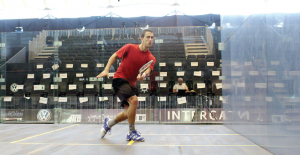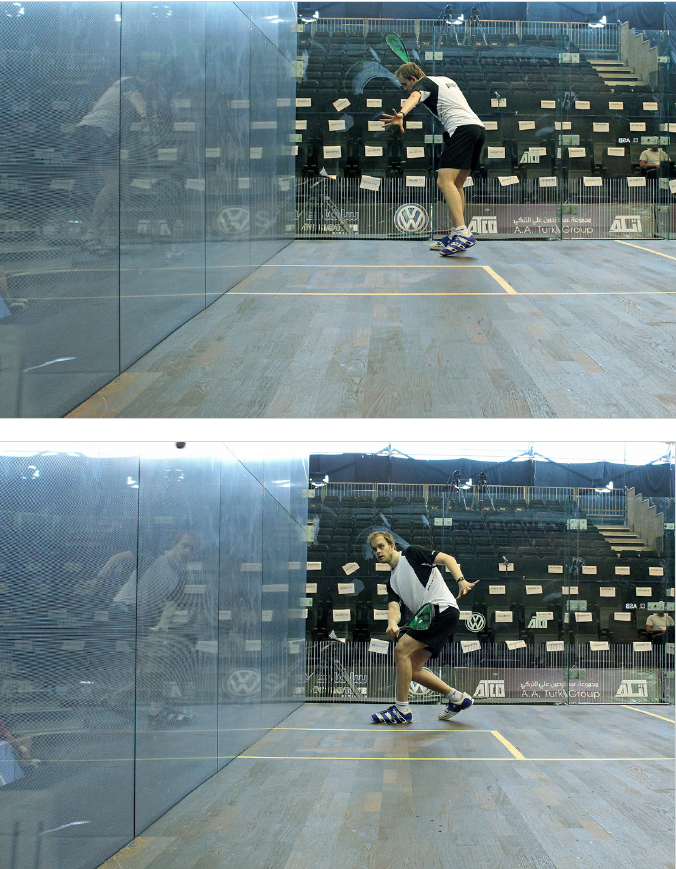By Richard Millman, Owner—Westchester Squash
One of my stock pieces of advice to enthusiastic players and the parents of enthusiastic juniors starts with the statement: “I have never known a top class player that hasn’t done hour upon hour of solo.”

And it’s true. Solo is a key determinant of whether or not a player with tremendous potential can realize that potential positively.
So what is ‘solo?’ The simple definition is: ‘Practicing alone.’ But to truly realize its value you need to have a clear plan and follow a structure.
First, give yourself targets and make sure you monitor and record how successfully you achieve your targets.
For instance, if your target is tightness, define your target range for tightness. If you are a serious intermediate player, a realistic target might be to try and hit 25 shots that land in the service box. If you are a little more advanced try hitting 50 or a 10.
Record your solo drill in a notebook along with the date and any comments you feel are relevant such as, “Hit 25 shots into the forehand service box. It took me 8 minutes.”
The next time you do the drill record the time again. As you improve give yourself different objectives: Hit 100 straight balls each side while trying to keep the ball within 12 floor boards of the side wall. Again record your rate of success.
But “Why,” someone might ask, “hit on your own, when you could play with a partner or hire a coach?”
The simple fact of the matter is that by practicing solo the frequency with which you have to play “tight from tight” is much higher and the numbers of shots you hit in any given period is much higher. So your practice is higher in quality and frequency.
If you look at the evidence presented by author Malcolm Gladwell in his recent book “Outliers” and by several other commentators on the assumption of skill, there are weighty opinions supporting the idea that 10,000 hours will produce results of expert or genius level.
Of course 10,000 hours is a great deal of time and it has also been accurately pointed out that simple time spent doesn’t produce excellence, but what you do during that time is what produces excellence.
Hence if you hit 100 balls down the sidewall without a clear plan, target, and a highly concentrated level of focus, you will likely hit the 100th ball as badly as the first. But if you stick to your objectives, make note of any consistent faults and make genuine strides to correct them, in my experience you will improve rapidly.
So not only solo, but quality, structured, focused solo.

Jonah Barrington used to do a wonderful volley solo drill where he would start off very close to the front wall hitting very short straight volleys and then gradually move backwards a step at a time until he reached the back wall, whereupon he would move forward again, one step at a time until he returned to the front. He might repeat that a number of times without making a mistake—a wonderful testament to his mental, physical and emotional capacity to focus.
Brett Martin told me that, early in his world-class career he decided to stop hitting the ball up and down the wall in solo and that he would do a different solo drill each time he came to practice, but would work on it until he could perfect it.
He showed me one drill he did where, standing in front forehand corner he played a volley about head height angled into the front wall corner so that it rebounded off of the forehand sidewall slightly behind him, whereupon he hit a backhand volley onto the backhand sidewall which then rebounded off of the forehand front wall onto the forehand sidewall, and then he repeated the whole drill about 40 times, without ever letting the ball hit the ground.
I asked Brett if there was ever a drill that he couldn’t do. He told me that there was one. His friend, the celebrated genius of the court, Tristan Nancarrow, could continuously hit the ball behind his back on the volley against the front wall. You might be thinking, well I can hit the ball behind my back. True, but can you hit it behind your back on your backhand and then, without letting the ball drop, reach across your front and around your back to hit the volley on the forehand behind your back!?!? And keep it going continuously? Brett told me he never could—partly because his torso wasn’t thin enough to reach all the way around.
I don’t mention these amazing solo drills as examples of things you should at- tempt. Rather to make you think about the amount of dedication and number of rep- etitions required to get to the point where these solo drills could be done consistently.
Here are some guidelines:
If you are a serious competitive player—not a pro—but an avid enthusiast, try setting yourself a goal of hitting 1,000 balls either side per week.
Generally, 500 balls takes me in the region of 30-40 minutes. So for 2,000 you need to allow something between two hours and two hours forty.
I particularly emphasize solo when I am peaking for a tournament. When I arrive a couple of days early for a tournament at a club where I haven’t played before, I consider a solo session to be essential in order to learn the peculiarities of a court I haven’t played on.
Plan your practice.
I like to do 150 deep straight drives on both the forehand and backhand sides, followed by 50 straight volleys each side from just behind the short line, followed by 100 figure of eight volleys (figure of eight is where you stand in the middle of the court just in front of the short line and volley the ball cross-court into the opposite angle, striking the front wall very close to the side wall so that it rebounds back toward yourself before you repeat the shot to the opposite side).
On other occasions after I hit my 150 straight drives each side, I do a combination solo drill where I hit one high floated length, then as the ball comes out of the back corner I feed myself a tight mid court ball (hitting just above the service line on the front wall and bouncing just in front of the service box) and then I hit an aggressive, sliced, short attacking ball. Then I start the three shot sequence again with the high straight length. I repeat the sequence 25 times.
Think of situations in your game that you would like to polish and then design your own solo drill to help attain the level of excellence and expertise you seek.
Be determined. Be patient. Be focused. When you have finished, write your notes. Make sure you maintain a positive tone about what you would like to do as you move forward. Many things are happening when you do solo. You are of course improving your stroke play, technique and control. You should be working on your movement and the coordination of your body in a seamless rhythmic and efficient dance that is your relationship with the ball.
You are strengthening your peripheral awareness. Reinforcing your specific understanding of where the walls are at any given time, the angles of the court, the spaces on the court.
Just as an aspiring artist or musician must do a variety of “studies” to perfect their skill, so must a squash player do their solo. I believe it was Dr Suzuki of violin method fame that said you should: “practice on as many days as you eat.”
Remember: I have never known a world class player that didn’t do hours and hours of solo.
So get to it and you too can be the Man from U.N.C.L.E! (Apologies if this reference is too obtuse or dated—look up Wikipedia: Napoleon Solo)”


